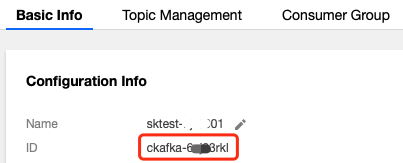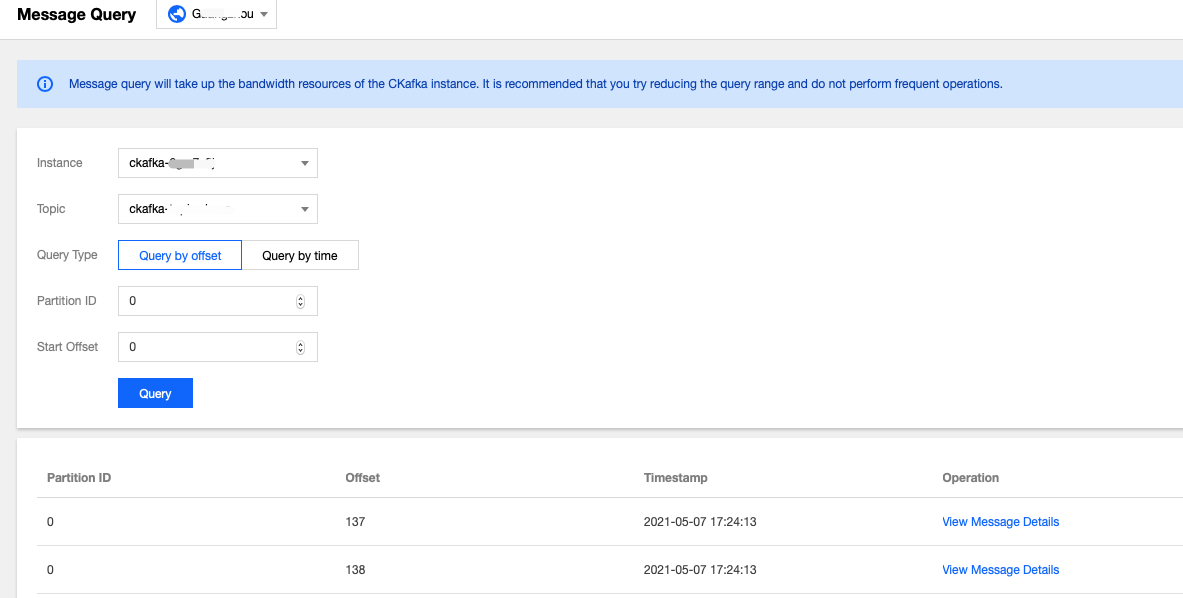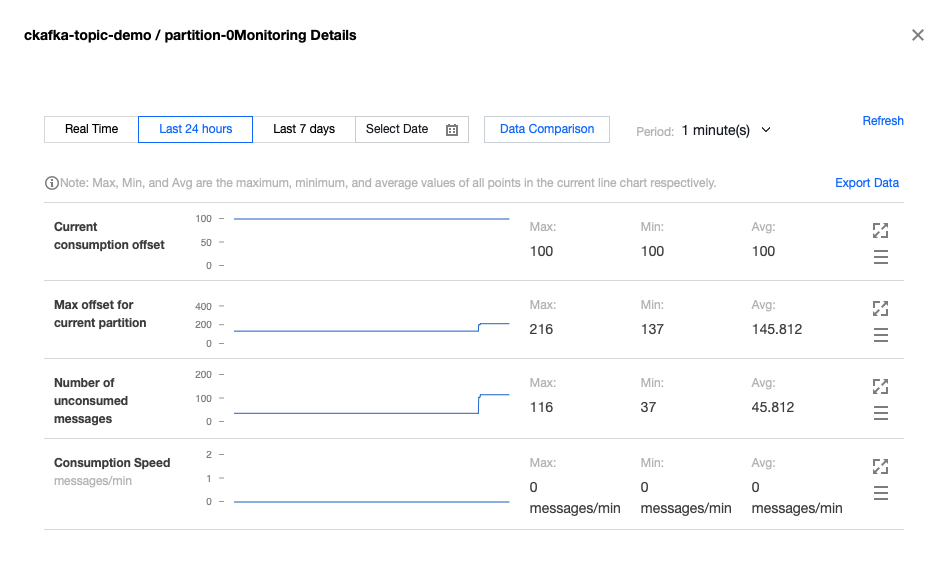- Release Notes and Announcements
- Product Introduction
- Purchase Guide
- Getting Started
- Operation Guide
- Instance Management
- Creating Instance
- Naming with Consecutive Numeric Suffixes or Designated Pattern String
- Viewing Instance
- Upgrading Instance
- Downgrading Instance Configuration
- Terminating/Returning Instances
- Change from Pay-as-You-Go to Monthly Subscription
- Upgrading Instance Version
- Adding Routing Policy
- Public Network Bandwidth Management
- Connecting to Prometheus
- AZ Migration
- Setting Maintenance Time
- Setting Message Size
- Topic Management
- Consumer Group
- Monitoring and Alarms
- Smart Ops
- Permission Management
- Tag Management
- Querying Message
- Event Center
- Migration to Cloud
- Data Compression
- Instance Management
- CKafka Connector
- Practical Tutorial
- Practical Tutorial of CKafka Client
- Connector Practical Tutorial
- Connecting Flink to CKafka
- Connecting Schema Registry to CKafka
- Connecting Spark Streaming to CKafka
- Connecting Flume to CKafka
- Connecting Kafka Connect to CKafka
- Connecting Storm to CKafka
- Connecting Logstash to CKafka
- Connecting Filebeat to CKafka
- Multi-AZ Deployment
- Log Access
- Replacing Supportive Route (Old)
- Practice Tutorial for Cluster Bandwidth in High CPU Utilization Scenarios
- Practice Tutorial for Cluster Capacity Planning
- Troubleshooting
- API Documentation
- History
- Introduction
- API Category
- Making API Requests
- DataHub APIs
- ACL APIs
- Topic APIs
- DescribeTopicProduceConnection
- BatchModifyGroupOffsets
- BatchModifyTopicAttributes
- CreateConsumer
- CreateDatahubTopic
- CreatePartition
- CreateTopic
- CreateTopicIpWhiteList
- DeleteTopic
- DeleteTopicIpWhiteList
- DescribeDatahubTopic
- DescribeTopic
- DescribeTopicAttributes
- DescribeTopicDetail
- DescribeTopicSubscribeGroup
- FetchMessageByOffset
- FetchMessageListByOffset
- ModifyDatahubTopic
- ModifyTopicAttributes
- DescribeTopicSyncReplica
- Instance APIs
- Route APIs
- Other APIs
- Data Types
- Error Codes
- SDK Documentation
- General References
- Conducting Production and Consumption Pressure Testing on CKafka
- Configuration Guide for Common Parameters in CKafka
- Connecting to Legacy Self-Built Kafka
- Suggestions for CKafka Version Selection
- CKafka Data Reliability Description
- Connector
- FAQs
- Service Level Agreement
- Contact Us
- Glossary
- Release Notes and Announcements
- Product Introduction
- Purchase Guide
- Getting Started
- Operation Guide
- Instance Management
- Creating Instance
- Naming with Consecutive Numeric Suffixes or Designated Pattern String
- Viewing Instance
- Upgrading Instance
- Downgrading Instance Configuration
- Terminating/Returning Instances
- Change from Pay-as-You-Go to Monthly Subscription
- Upgrading Instance Version
- Adding Routing Policy
- Public Network Bandwidth Management
- Connecting to Prometheus
- AZ Migration
- Setting Maintenance Time
- Setting Message Size
- Topic Management
- Consumer Group
- Monitoring and Alarms
- Smart Ops
- Permission Management
- Tag Management
- Querying Message
- Event Center
- Migration to Cloud
- Data Compression
- Instance Management
- CKafka Connector
- Practical Tutorial
- Practical Tutorial of CKafka Client
- Connector Practical Tutorial
- Connecting Flink to CKafka
- Connecting Schema Registry to CKafka
- Connecting Spark Streaming to CKafka
- Connecting Flume to CKafka
- Connecting Kafka Connect to CKafka
- Connecting Storm to CKafka
- Connecting Logstash to CKafka
- Connecting Filebeat to CKafka
- Multi-AZ Deployment
- Log Access
- Replacing Supportive Route (Old)
- Practice Tutorial for Cluster Bandwidth in High CPU Utilization Scenarios
- Practice Tutorial for Cluster Capacity Planning
- Troubleshooting
- API Documentation
- History
- Introduction
- API Category
- Making API Requests
- DataHub APIs
- ACL APIs
- Topic APIs
- DescribeTopicProduceConnection
- BatchModifyGroupOffsets
- BatchModifyTopicAttributes
- CreateConsumer
- CreateDatahubTopic
- CreatePartition
- CreateTopic
- CreateTopicIpWhiteList
- DeleteTopic
- DeleteTopicIpWhiteList
- DescribeDatahubTopic
- DescribeTopic
- DescribeTopicAttributes
- DescribeTopicDetail
- DescribeTopicSubscribeGroup
- FetchMessageByOffset
- FetchMessageListByOffset
- ModifyDatahubTopic
- ModifyTopicAttributes
- DescribeTopicSyncReplica
- Instance APIs
- Route APIs
- Other APIs
- Data Types
- Error Codes
- SDK Documentation
- General References
- Conducting Production and Consumption Pressure Testing on CKafka
- Configuration Guide for Common Parameters in CKafka
- Connecting to Legacy Self-Built Kafka
- Suggestions for CKafka Version Selection
- CKafka Data Reliability Description
- Connector
- FAQs
- Service Level Agreement
- Contact Us
- Glossary
Overview
This document describes how to access CKafka to send/receive messages with the SDK for Go through SASL_PLAINTEXT over public network.
Prerequisites
Directions
Step 1. Prepare the Go dependent library
Download the demo, enter the
gokafkademo directory, and run the following command to install it.go get -v gopkg.in/confluentinc/confluent-kafka-go.v1/kafka
Step 2. Prepare configurations
Create a configuration file named
kafka.json.{"topic": ["xxxx"],"sasl": {"username": "yourUserName","password": "yourPassword","instanceId":"instanceId"},"bootstrapServers": ["xxx.ap-changsha-ec.ckafka.tencentcloudmq.com:6000"],"consumerGroupId": "yourConsumerId"}
Parameter | Description |
topic | Topic name, which can be copied in Topic Management on the instance details page in the console.  |
sasl.username | Username, which is set when the user is created in User Management on the instance details page in the console. |
sasl.password | Password, which is set when the user is created in User Management on the instance details page in the console. |
sasl.instanceId | Instance ID, which can be obtained in Basic Info on the instance details page in the console.  |
bootstrapServers | Accessed network, which can be copied from the Network column in the Access Mode section in Basic Info on the instance details page in the console.  |
consumerGroupId | You can customize it. After the demo runs successfully, you can see the consumer on the Consumer Group page. |
Step 3. Send messages
1. Write a message production program.
package mainimport ("fmt""gokafkademo/config""log""strings""github.com/confluentinc/confluent-kafka-go/kafka")func main() {cfg, err := config.ParseConfig("../config/kafka.json")if err != nil {log.Fatal(err)}p, err := kafka.NewProducer(&kafka.ConfigMap{// Set the access point of the corresponding topic, which can be obtained in the console"bootstrap.servers": strings.Join(cfg.Servers, ","),// The SASL authentication mechanism is PLAIN by default"sasl.mechanism": "PLAIN",// Configure an ACL policy locally"security.protocol": "SASL_PLAINTEXT",// Set “username” to a value in the format of “instance ID + # + configured username”, and “password” to the configured password"sasl.username": fmt.Sprintf("%s#%s", cfg.SASL.InstanceId, cfg.SASL.Username),"sasl.password": cfg.SASL.Password,// Kafka producer supports 3 ACK mechanisms:// -1 or all: the broker responds to the producer and continues to send the next message or next batch of messages only after the leader receives the data and syncs it to followers in all ISRs.// This configuration provides the highest data reliability, as messages will never get lost as long as one synced replica survives. It should be noted that this configuration cannot guarantee that replicas will be returned after data has been read from or written to all of them.// It can be used together with the “min.insync.replicas” parameter at the topic level.// 0: the producer continues to send the next message or next batch of messages without waiting for the broker’s acknowledgment of sync. This configuration provides the highest production performance but the lowest data reliability as data may get lost when the server fails. If the leader is dead but the producer is unaware of that, the broker cannot receive messages.// 1: the producer sends the next message or next batch of messages after it receives an acknowledgment that the leader has successfully received the data. This configuration is a balance between production throughput and data reliability. Messages may get lost if the leader is dead but has not been replicated yet.// If you do not configure this parameter, the default value will be 1. You can customize this according to your business requirements."acks": 1,// Number of retries upon request error. It is recommended that you set the parameter to a value greater than 0 to enable retries and guarantee that messages are not lost to the greatest extent possible."retries": 0,// Retry interval upon request failure"retry.backoff.ms": 100,// Timeout duration of a producer network request"socket.timeout.ms": 6000,// Set the interval between retries for the client"reconnect.backoff.max.ms": 3000,})if err != nil {log.Fatal(err)}defer p.Close()// Deliver the produced messages to the report processorgo func() {for e := range p.Events() {switch ev := e.(type) {case *kafka.Message:if ev.TopicPartition.Error != nil {fmt.Printf("Delivery failed: %v\\n", ev.TopicPartition)} else {fmt.Printf("Delivered message to %v\\n", ev.TopicPartition)}}}}()// Send messages in async modetopic := cfg.Topicfor _, word := range []string{"Confluent-Kafka", "Golang Client Message"} {_ = p.Produce(&kafka.Message{TopicPartition: kafka.TopicPartition{Topic: &topic, Partition: kafka.PartitionAny},Value: []byte(word),}, nil)}// Wait for message deliveryp.Flush(10 * 1000)
2. Compile and run the program to send messages.
go run main.go
3. View the execution result. Below is a sample:
Delivered message to test[0]@628Delivered message to test[0]@629
4. On the Topic Management tab page on the instance details page in the CKafka console, select the corresponding topic, and click More > Message Query to view the messages just sent.


Step 4. Consume messages
1. Write the message consumption program.
package mainimport ("fmt""gokafkademo/config""log""strings""github.com/confluentinc/confluent-kafka-go/kafka")func main() {cfg, err := config.ParseConfig("../config/kafka.json")if err != nil {log.Fatal(err)}c, err := kafka.NewConsumer(&kafka.ConfigMap{// Set the access point of the corresponding topic, which can be obtained in the console"bootstrap.servers": strings.Join(cfg.Servers, ","),// The SASL authentication mechanism is PLAIN by default"sasl.mechanism": "PLAIN",// Configure an ACL policy locally"security.protocol": "SASL_PLAINTEXT",// Set “username” to a value in the format of “instance ID + # + configured username”, and “password” to the configured password"sasl.username": fmt.Sprintf("%s#%s", cfg.SASL.InstanceId, cfg.SASL.Username),"sasl.password": cfg.SASL.Password,// The set message consumer group"group.id": cfg.ConsumerGroupId,"auto.offset.reset": "earliest",// Consumer timeout period when the Kafka consumer grouping mechanism is used. If the broker does not receive the heartbeat of the consumer within this period, the consumer will be considered to have failed and the broker will initiate rebalance.// Currently, this value must be configured in the broker between 6000 (value of group.min.session.timeout.ms) and 300000 (value of group.max.session.timeout.ms)."session.timeout.ms": 10000,})if err != nil {log.Fatal(err)}// List of subscribed message topicserr = c.SubscribeTopics([]string{"test", "test-topic"}, nil)if err != nil {log.Fatal(err)}for {msg, err := c.ReadMessage(-1)if err == nil {fmt.Printf("Message on %s: %s\\n", msg.TopicPartition, string(msg.Value))} else {// The client will automatically try to recover all errorsfmt.Printf("Consumer error: %v (%v)\\n", err, msg)}}c.Close()}
2. Compile and run the program to consume messages.
go run main.go
3. View the execution result. Below is a sample:
Message on test[0]@628: Confluent-KafkaMessage on test[0]@629: Golang Client Message
4. On the Consumer Group tab page on the instance details page in the CKafka console, select the corresponding consumer group, enter the topic name, and click View Details to view the consumption details.


 예
예
 아니오
아니오
문제 해결에 도움이 되었나요?